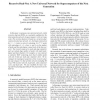Free Online Productivity Tools
i2Speak
i2Symbol
i2OCR
iTex2Img
iWeb2Print
iWeb2Shot
i2Type
iPdf2Split
iPdf2Merge
i2Bopomofo
i2Arabic
i2Style
i2Image
i2PDF
iLatex2Rtf
Sci2ools
ICA3PP
2009
Springer
2009
Springer
Recursive Dual-Net: A New Universal Network for Supercomputers of the Next Generation
In this paper, we propose a new universal network, called recursive dual-net (RDN), as a potential candidate for the interconnection network of supercomputers with very large scale. The recursive dual-net is based on a recursive dualconstruction of a base network. A k-level dual-construction for k > 0 creates a network containing (2m)2k /2 nodes with node-degree d + k, where m and d are the number of nodes and the node-degree, respectively, of the base network. The recursive dual-net is node and edge symmetric and can contain huge number of nodes with small nodedegree and short diameter. For example, we can construct a symmetric RDN connecting more than 3-million nodes with only 6 links per node and a diameter of 22. We investigate the topological properties of the recursive dualnet and compare it to that of other networks including 3D torus, WK-recursive network, hypercube, cube-connectedcycle, and dual-cube. We also establish the basic routing and broadcasting algorithms for the ...
Base Network | Distributed And Parallel Computing | ICA3PP 2009 | Recursive Dual-net | Recursive Dualconstruction |
| Added | 25 Jul 2010 |
| Updated | 25 Jul 2010 |
| Type | Conference |
| Year | 2009 |
| Where | ICA3PP |
| Authors | Yamin Li, Shietung Peng, Wanming Chu |
Comments (0)

